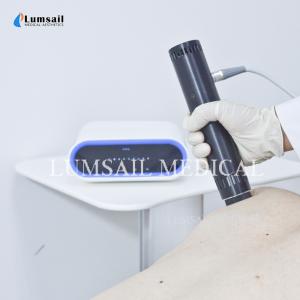
Add to Cart
Frozen shoulder (Adhesive Capsulitis) AWT Acoustic Wave Therapy Machine
What is Frozen shoulder (Adhesive Capsulitis)?
Frozen shoulder, also called adhesive capsulitis, is a painful condition in which the movement of the shoulder becomes limited.
Frozen shoulder occurs when the strong connective tissue surrounding the shoulder joint (called the shoulder joint capsule) become thick, stiff, and inflamed. (The joint capsule contains the ligaments that attach the top of the upper arm bone [humeral head] to the shoulder socket [glenoid], firmly holding the joint in place. This is more commonly known as the "ball and socket" joint.)
The condition is called "frozen" shoulder because the more pain that is felt, the less likely the shoulder will be used. Lack of use causes the shoulder capsule to thicken and becomes tight, making the shoulder even more difficult to move -- it is "frozen" in its position.
What is Miniwave Shockwave Therapy?
Miniwave Shockwave Therapy is a method of therapy that uses a device to send acoustic waves of high energy pulses into an injury affected area on a person's body. The device works by creating a microtrauma to the affected area, thus stimulating blood flow and thereby promoting tissue healing. In chronic pain, these Shockwaves create a new inflammatory process, which then kick starts the brain to react by sending the necessary nutrients to promote healing.
Benefits of Miniwave Shockwave Therapy include:
Specifications for Miniwave Shockwave Therapy Machine
| MINIWAVE Parameter | Basic Version | Pro Version |
| Energy | 10-150mJ, totally 9 levels | 10-190mJ, stepping 5mJ |
| Frequency | 1-14Hz, totally 9 levels | 1-21Hz, stepping 1 Hz |
| Pre-set protocols | 5 pre-set protocols, programmable | More than 40 pre-set protocols, customizable |
| Bluetooth | None | YES |
| APP on mobile device | None | YES, Available for Android & IOS |
| History records management | None | YES |
| Operator management | None | YES |
| Rental management | None | YES |
| Main unit dimension | 200 (width) x 230 (length) x 78 (height) mm | |
| Main unit weight | 1.27Kg | |
| Applicator dimension | 210 (length) x 50 (diameter) mm | |
| Applicator weight | 0.6Kg | |
| Pulse Mode | Continuous | |
| Output channel | Dual-channel output, max 2 applicators can connect together | |
| Transmitter | 6 fully alloy made transmitters 6mm / 15mm B /15mm U / 15mm F / 25mm / 36mm | |
| Applicator lifespan | 2 million shots or more | |
| Transmitter lifespan | 300K shots or more | |
| Control panel on main unit | Finger-swing touch control with OLED screen | |
| Control panel on applicator | 5-buttons panel with OLED screen | |
| Foot pedal | 360 degree foot pedal as optional accessory | |
| Firmware upgradable | Yes, via SD card | |
| Power | AC mode: Max.250W, AC110V-240V, 50/60Hz Cordless DC mode: External Lithium-ion battery *Battery is optional accessory, not included by default | |
| Fuse | F5 AC250V, 3A | |
| Packing | Aluminum hand case with shaped foam, with carton outside | |
FAQ for Miniwave Shockwave Therapy
Is there a situation or condition where Shockwave Therapy cannot be used?
Shockwave Therapy is not advised:
How many sessions of Miniwave Shockwave Therapy do I need?
Effects start to occur after just 1 session. Most patients will notice a significant improvement in their pain symptoms & recovery within 3-4 sessions & a full treatment course is approximately 12 sessions. Your Physiotherapist will likely combine this with other modalities of treatment to give you the best outcome.
What does Miniwave Shockwave Therapy feel like?
People may experience mild discomfort during the treatment. As the area becomes desensitized, the initial discomfort typically fades as it is being treated.
How is the Shockwave treatment performed?
The treatment is noninvasive. First, a gel is applied to the treatment area. Second, an applicator is applied and manipulated to release pressure waves over the affected area. Treatment sessions typically last 5 minutes, but this can vary depending on the area(s) and condition being treated.
What type of results are expected?
Beneficial effects are often experienced after only one or two treatments, and many patients report immediate relief. The technology has a 91% success rate as per clinical studies.
What are the possible side effects?
Treatment with Shockwave technology has virtually no side effects. In some cases, patients may experience minor discomfort for a few days. Patients can return to work after treatments and in most all cases there is no downtime.
Who is a candidate for Shockwave therapy?
Most people are excellent candidates for Shockwave treatment however patients who are pregnant, have a pacemaker or current cancer are not suitable for treatment with Shockwave Technology.




